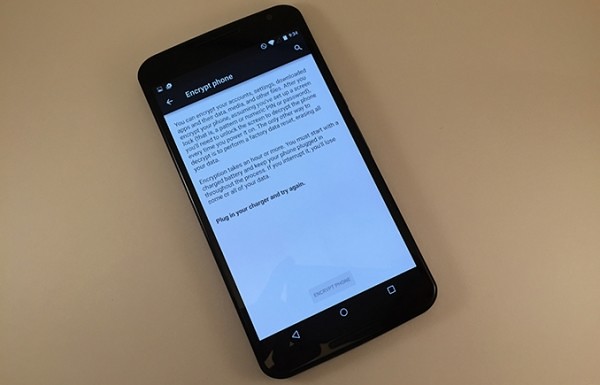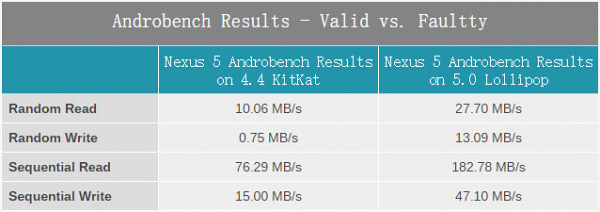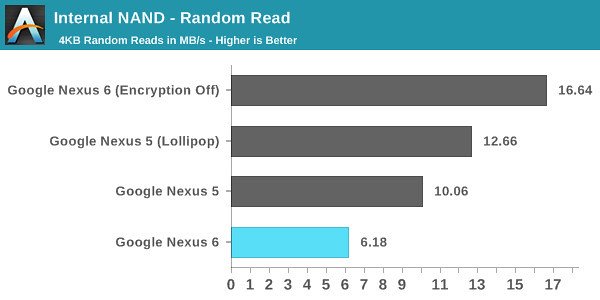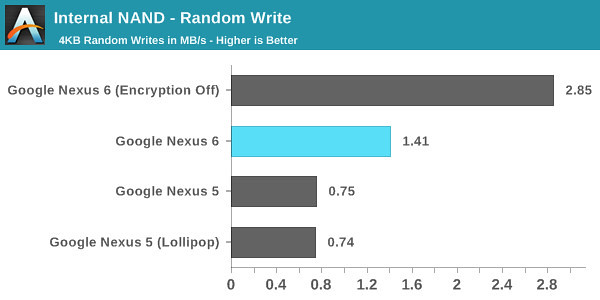Comprehensive data encryption in Android 3.0 era appeared, but Google's Nexus 6 until 2014 until this feature is enabled by default, the biggest reason is the impact of this feature on phone memory read and write performance, how big is the effect of, please see our test.


Evaluation of devices running Android before 5.0, our regular eMMC reading and writing of abnormal test results, run Android Nexus 5.0 developer preview release 5, memory read and write speeds using the Androbench test, Android under 5.0 results compared to 2~10 What Android under 4.4 times the increase, which is after the probe, We found that the main reason for this problem is the software that we use to test Android system Androbench in the calculation of results is a time within the algorithm, this algorithm is not the same in 4.4 and 5.0. iPhone 6 plus Moschino
So we swap with another piece of software AndEBench testing the software function and Androbench is similar, but the software itself is used by lower-level instructions, so Android from 4.4 to 5.0 did not affect the outcome of the software.
In addition, we discovered during evaluation of the Nexus 6, original Nexus 6 carrying Android 5.0 default in factory condition the Android-enabled full disk encryption features (Full Disk Encryption, hereinafter FDE), which appeared on the first Android 3.0 system, but Google has only 5.0 system the function is switched on by default. FDE opens, encrypt all data will be written to the memory before the write, read from the memory data is encrypted prior to treatment, must also be decrypted. Decrypt the key nature of the lock screen is user password, which means that whoever got the phone cannot read mobile phone data without the password.
However, Android phones and not quite as on the FDE and SSD, SSD on the FDE function is often the primary hardware support, and eMMC chip is designed for use on mobile phones isn't at the beginning of this module, most SoC does not have hardware-level support for FDE. Joined early in the design of SoC hardware module support FDE performance impact is negligible, or even negligible.
So it's all explained in an earlier column, by default open FDE Nexus 6, we find the most obvious performance degradation, flush is not enabled by default after FDE firmware released Motorola, we compared the test results of both, in contrast, we have also added a Nexus 5.



Charts, Nexus 5 (Lollipop) data are test 5.0 use AndEBench after the upgrade, Nexus 5 is down 4.4 results, and it is important to note, Nexus 5 via OTA or brushes fit in like package is not opened automatically after the upgrade to 5.0 system of the FDE function.
From above of test results not difficult see, using software achieved of FDE will led to serious of read and write performance declined: random read performance declined 62.9%, random writes performance declined 50.5%, and sequence read performance more is declined has amazing of 80.7%, as long as user let phone for need on memory for read and write of operation, FDE for performance of effect is visible of, furthermore for, Google default opened FDE function may for improve user actual using of security and no too big help-- In terms of security, after all, the dominant user behavior is also very important, and the encrypted data on the Nexus 6 is only through password or gestures to the protection, if you don't set a password to unlock, FDE security is all equipment, have no use but to affect performance.
In evaluation Nexus 6 of when, I also found Nexus 6 in some when will has performance short Board problem, and this a problem in run Android 5.0 of Nexus 5 Shang does not exists, initially we think this may is FDE due to, but in brush into close FDE of firmware zhihou, for performance of upgrade is does not obviously, at least than above test of so obviously, in Messenger and calendar APP among still has obviously of hanging needle problem, So the problem is at the moment can only be blamed on the Nexus 6 using the GPU or the bandwidth of the processor is not enough to cope with the 2K screen.
For me, Google forced open on Nexus 6 FDE is perhaps in this context was justifiable, enhanced data security is of course necessary, but such a simple and crude solution at the expense of performance, I think it is less desirable. In the future, I hope Google cancel FDE setting enabled by default, or take other measures to minimize FDE performance impact.
Via Anandtech Moschino cases

No comments:
Post a Comment